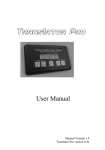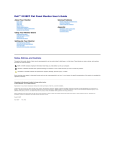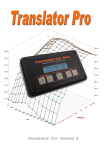Download Dell 2009WFP Specifications
Transcript
Dell™ 2009W Flat Panel Monitor User's Guide About Your Monitor Solving Problems Product Features Identifying Parts and Controls Monitor Specifications Universal Serial Bus (USB) Interface Plug and Play Capability Maintenance Guidelines Setting Up the Monitor Attaching the Stand Connecting the Monitor Organizing the Cables Attaching the Soundbar (Optional) Removing the Stand Troubleshooting Your Monitor Common Problems Product Specific Problems Universal Serial Bus (USB) Specific Problems Troubleshooting the Dell™ Soundbar Appendix Safety Instructions FCC Notice (U.S. Only) and Other Regulatory Information Contacting Dell Operating the Monitor Using the Front Panel Controls Using the On-Screen Display (OSD) Setting the Optimal Resolution Using the Dell Soundbar (Optional) Using the Tilt, Swivel, and Vertical Extension Rotating the monitor Adjusting the Rotation Settings of Your Operating System Notes, Notices, and Cautions NOTE: A NOTE indicates important information that helps you make better use of your computer. NOTICE: A NOTICE indicates either potential damage to hardware or loss of data and tells you how to avoid the problem. CAUTION: A CAUTION indicates a potential for property damage, personal injury, or death. Information in this document is subject to change without notice. © 2008 Dell Inc. All rights reserved. Reproduction in any manner whatsoever without the written permission of Dell Inc. is strictly forbidden. Trademarks used in this text: Dell, the DELL logo are trademarks of Dell Inc; Microsoft, Windows, and Windows NT are registered trademarks of Microsoft Corporation; Adobe is a trademark of Adobe Systems Incorporated, which may be registered in certain jurisdictions. ENERGY STAR is a registered trademark of the U.S. Environmental Protection Agency. As an ENERGY STAR partner, Dell Inc. has determined that this product meets the ENERGY STAR guidelines for energy efficiency. Other trademarks and trade names may be used in this document to refer to either the entities claiming the marks and names or their products. Dell Inc. disclaims any proprietary interest in trademarks and trade names other than its own. Model 2009W January 2008 Rev. A00 Downloaded from ManualMonitor.com Manuals Back to Contents Page About Your Monitor Dell™ 2009W Flat Panel Monitor User's Guide Product Features Identifying Parts and Controls Monitor Specifications Universal Serial Bus (USB) Interface Plug and Play Capability Maintenance Guidelines Product Features The Dell™ 2009W flat panel display has an active matrix, thin-film transistor (TFT), liquid crystal display (LCD). The monitor features include: ■ 20-inch (508 mm) viewable area display. ■ 1680 x 1050 resolution, plus full-screen support for lower resolutions. ■ Wide viewing angle to allow viewing from a sitting or standing position, or moving side-to-side. ■ Tilt, swivel, vertical extension and rotate adjustment capabilities. ■ Removable pedestal and VESA 100 mm mounting holes for flexible mounting solutions. ■ Plug and play capability if supported by your system. ■ On-Screen Display (OSD) adjustments for ease of set-up and screen optimization. ■ Software and documentation CD includes an information file (INF), Image color Matching File (ICM), and product documentation. ■ Energy Saver feature for Energy Star compliance. ■ Security lock slot. Identifying Parts and Features Front View Front View Label Description 1 Input Source select 2 OSD Menu/Select button Downloaded from ManualMonitor.com Manuals Front panel controls 3 Brightness & Contrast/Down (-) button 4 Auto-adjust/Up (+) button 5 Power button (with power light indicator) Back View Back view Back View with monitor stand Label Description/Use 1 VESA mounting holes (100mm) (Behind attached base plate) Use to mount the monitor. 2 Barcode serial number label Refer to this label if you need to contact Dell for technical support. 3 Security lock slot Use a security lock with the slot to help secure your monitor. 4 Dell Soundbar mounting brackets Attach the optional Dell Soundbar. 5 Regulatory rating label Lists the regulatory approvals. 6 Stand removal button Press to release the stand. 7 Cable management slot Help organize cables by placing them through the slot. 8 Lock down/release button Push the monitor down, press the button to unlock the monitor, and then lift the monitor to the desired height. Side View USB connectors (downstream) Left view Downloaded from ManualMonitor.com Manuals Right view Bottom View Bottom view Bottom view with monitor stand Label Description 1 AC power cord connector 2 DC power connector for Dell Soundbar 3 DVI connector 4 VGA connector 5 USB upstream port 6 USB downstream ports Monitor Specifications The following sections give you information about the various power management modes and pin assignments for various connectors for your monitor. Power Management Modes If you have VESA's DPM™ compliance display card or software installed in your PC, the monitor can automatically reduce its power consumption when not in use. This is referred to as Mode*. If the computer detects input from keyboard, mouse, or other input devices, the monitor automatically resumes functioning. The following table shows the power consumption and of this automatic power saving feature: VESA Modes Horizontal Sync Vertical Sync Video Power Indicator Power Consumption Normal operation (with Dell Soundbar and USB active) Active Active Active Green 70 W (maximum) Normal operation Active Active Active Green 42 W (typical) Active-off mode Inactive Inactive Blanked Amber Less than 2 W Switch off - - - Off Less than 1 W The OSD will only function in the normal operation mode. When the menu or plus buttons are pressed in Active-off mode, one of the following messages will be displayed: Analog Input In Power Save Mode. Press Computer Power Button or Any Key on Keyboard or Move Mouse OR Digital Input In Power Save Mode. Press Computer Power Button or Any Key on Keyboard or Move Mouse Activate the computer and the monitor to gain access to the OSD. NOTE: This monitor is ENERGY STAR®-compliant as well as TCO '99/TCO '03 power management compatible. * Zero power consumption in OFF mode can only be achieved by disconnecting the main cable from the monitor. Downloaded from ManualMonitor.com Manuals Pin Assignments VGA Connector Pin 15-pin Side of the Connected Signal Cable Number 1 Video-Red 2 Video-Green 3 Video-Blue 4 GND 5 Self-test 6 GND-R 7 GND-G 8 GND-B 9 Computer 5V/3.3V 10 GND-sync 11 GND 12 DDC data 13 H-sync 14 V-sync 15 DDC clock DVI Connector Pin Number 1 24-pin Side of the Connected Signal Cable 2 TMDS RX2+ 3 TMDS Ground 4 Floating 5 Floating 6 DDC Clock 7 DDC Data 8 Floating TMDS RX2- Downloaded from ManualMonitor.com Manuals 9 TMDS RX1- 10 TMDS RX1+ 11 TMDS Ground 12 Floating 13 Floating 14 +5V/+3.3V power 15 Self test 16 Hot Plug Detect 17 TMDS RX0- 18 TMDS RX0+ 19 TMDS Ground 20 Floating 21 Floating 22 TMDS Ground 23 TMDS Clock+ 24 TMDS Clock- Downloaded from ManualMonitor.com Manuals Universal Serial Bus (USB) Interface This section gives you information about the USB ports that are available on the left side of your monitor. NOTE: This monitor supports High-Speed Certified USB 2.0 interface Transfer speed Data Rate Power Consumption High speed 480 Mbps 2.5W (Max., each port) Full speed 12 Mbps 2.5W (Max., each port) Low speed 1.5 Mbps 2.5W (Max., each port) USB Upstream Connector Pin Number 1 4-pin Side of the connector DMU 2 VCC 3 DPU 4 GND USB Downstream Connector Pin Number 1 4-Pin Side of the Signal Cable VCC 2 DMD 3 DPD 4 GND USB Ports l l 1 upstream - rear 4 downstream - 2 on rear; 2 on left side NOTE: USB 2.0 functionality requires a USB 2.0-capable computer. NOTE: The monitor's USB interface works only when the monitor is on or in power save mode. If you turn off the monitor and then turn it on, the attached peripherals may take a few to resume normal functionality. Downloaded from ManualMonitor.com Manuals Plug and Play Capability You can install the monitor in any Plug and Play-compatible system. The monitor automatically provides the computer system with its Extended Display Identification Data (EDID) using Dis Channel (DDC) protocols so the system can configure itself and optimize the monitor settings. Most monitor installations are automatic; you can select different settings if desired. F information about changing the monitor settings, see Operating the Monitor. Flat Panel Specifications Screen type Active matrix - TFT LCD Screen dimensions 20 inches (20-inch viewable image size) Preset display area: Horizontal 433.44 mm (17.06 inches) Vertical 270.90 mm (10.67 inches) Pixel pitch 0.258 mm Viewing angle 160° (vertical) typ, 170° (horizontal) typ Luminance output 300 cd/m ²(typ) Contrast ratio 1000 to 1 (typ) Dynamic contrast ratio 2000 to 1 (typ) Faceplate coating Antiglare with hard-coating 3H Backlight CCFL (4) edgelight system Response Time 5ms typical Color gamut (Typical) 102%* * 2009W color gamut (typical) is based on CIE1976 (102%) and CIE1931 (92%) test standards. Downloaded from ManualMonitor.com Manuals Downloaded from ManualMonitor.com Manuals Back to Contents Page Appendix Dell™ 2009W Flat Panel Monitor User's Guide Safety Instructions FCC Notice (U.S. Only) and Other Regulatory Information Contacting Dell CAUTION: Safety Instructions CAUTION: Use of controls, adjustments, or procedures other than those specified in this documentation may result in exposure to shock, electrical hazards, and/or mechanical hazards. For information on safety instructions, see the Product Information Guide. FCC Notices (U.S. Only) and Other Regulatory Information For FCC notices and other regulatory information, see the regulatory compliance website located at: http://www.dell.com/regulatory_compliance. Contacting Dell For customers in the United States, call 800-WWW-DELL (800-999-3355). NOTE: If you do not have an active Internet connection, you can find contact information on your purchase invoice, packing slip, bill, or Dell product catalog. Dell provides several online and telephone-based support and service options. Availability varies by country and product, and some services may not be available in your area. To contact Dell for sales, technical support, or customer service issues: 1. 2. 3. 4. 5. Visit support.dell.com. Verify your country or region in the Choose A Country/Region drop-down menu at the bottom of the page. Click Contact Us on the left side of the page. Select the appropriate service or support link based on your need. Choose the method of contacting Dell that is convenient for you. Back to Contents Page Downloaded from ManualMonitor.com Manuals Back to Contents Page Operating the Monitor Dell™ 2009W Flat Panel Monitor User's Guide Using the Front Panel Controls Using the On-Screen Display (OSD) Menu Setting the Optimal Resolution Using the Dell Soundbar (Optional) Using the Tilt, Swivel, and Vertical Extension Rotating the monitor Adjusting the Rotation Display Settings of Your System Using the Front Panel Use the control buttons on the front of the monitor to adjust the characteristics of the image being displayed. As you use these buttons to adjust the controls, an OSD shows the numeric values of the characteristics as they change. Front panel Button A Description Use Input Source Select button to select between two different video signals that may be connected to your monitor. l l Input Source Select VGA input DVI-D input If both VGA and DVI cables are connected to one PC, this monitor displays an image automatically as long as a video signal is present in either VGA or DVI outputs. On a display connected to two PCs, set equal time for both screen savers. The video input from the movement of the first mouse will activate the display. As you cycle through the inputs appear the following messages to indicate currently selected input source. It may take 1 or 2 seconds for the image to appear. or or If either VGA or DVI-D input is selected and both VGA and DVI-D cables are not connected, a floating dialog box as shown below appears. or or Use the MENU button to launch the on-screen display (OSD) and select the OSD Menu. See Accessing the Menu System. B OSD Menu/Select Downloaded from ManualMonitor.com Manuals C Use this button for direct access to the "Brightness" and "Contrast" control menu. Brightness/Contrast Hot Key C and D Use these buttons to navigate and adjust the slider-bar (decrease/increase ranges) controls in the OSD. Down (-) and Up (+) D Use this button to activate automatic setup and adjust menu. The following dialog appears on a black screen as the monitor selfadjusts to the current input: Auto Adjust Auto Adjustment allows the monitor to self-adjust to the incoming video signal. After using Auto Adjustment, you can further tune your monitor by using the Pixel Clock (Coarse) and Phase (Fine) controls under DISPLAY SETTINGS. NOTE: Auto Adjust does not occur if you press the button while there are no active video input signals or attached cables. E Use the Power button to turn the monitor on and off. The green LED indicates the monitor is on and fully functional. An amber LED indicates DPMS power save mode. Power button (with power light indicator) Using the On-Screen Display (OSD) Menu Accessing the Menu System NOTE: If you change the settings and then either proceed to another menu or exit the OSD menu, the monitor automatically saves those changes. The changes are also saved if you change the settings and then wait for the OSD menu to disappear. 1. Push the MENU button to launch the OSD menu and display the main menu. Main Menu for Analog (VGA) Input or Main Menu for non Analog (non VGA) Input NOTE: AUTO ADJUST is only available when you are using the analog (VGA) connector. 2. Push the and buttons to move between the setting options. As you move from one icon to another, the option name is highlighted. See the following table for a complete list of all the options available for the monitor. 3. 4. Push the MENU button once to activate the highlighted option. 5. Push 6. Select the "back" option to return to the main menu or "exit" to exit the OSD menu. Push the Icon and buttons to select the desired parameter. to enter the slide bar and then use the Menu and Submenus Description Downloaded from ManualMonitor.com Manuals or button, according to the indicators on the menu, to make your changes. EXIT Select to exit the main menu. BRIGHTNESS & CONTRAST Use this menu to activate Brightness/Contrast adjustment. Back Push Brightness Brightness adjusts the luminance of the backlight. to go back to the main menu. Push the Contrast button to increase brightness and push the button to decrease brightness (min 0 ~ max 100). Adjust Brightness first, and then adjust Contrast only if further adjustment is necessary. Push the button to increase contrast and push the button to decrease contrast (min 0 ~ max 100). The Contrast function adjusts the degree of difference between darkness and lightness on the monitor screen. Exit Menu AUTO ADJUST Push to exit the OSD main menu. Even though your computer recognizes your monitor on startup, the Auto Adjustment function optimizes the display settings for use with your particular setup. NOTE: In most cases, Auto Adjust produces the best image for your configuration. NOTE: AUTO ADJUST option is only available when you are using the analog (VGA) connector. INPUT SOURCE Use the INPUT SOURCE menu to select between different video signals that may be connected to your monitor. Back Push VGA Select VGA input when you are using the analog (VGA) connector. Push to select the VGA input source. DVI-D Select DVI-D input when you are using the Digital (DVI) connector. Push to select the DVI input source. Scan for Source Push Exit Menu Push PRESET to go back to the main menu. to scan for available input signals. to exit the OSD main menu. Use the Preset Modes to adjust the color setting mode and color temperature. SETTING Downloaded from ManualMonitor.com Manuals Preset setting submenu Back Push Input Color Format To achieve the different color domain for PC RGB and HD YPbPr (HD YPbPr is suitable for HD video playback over DVI. PC RGB is suitable for normal PC graphics display over DVI). Gamma To achieve the different color mode for PC and Mac. Color Setting mode You can choose between a Graphics and a Video mode. If your computer is connected to your monitor, choose Graphics. If a DVD, STB, or VCR is connected to your monitor, choose Video. to go back to the main menu. Color Presets To achieve the different color domain for PC RGB and HD YPbPr (HD YPbPr is suitable for HD video playback over DVI. PC RGB is (VGA/DVI-D suitable for normal PC graphics display over DVI). Input) Desktop Mode Mode suitable for desktop applications. Multimedia Mode Mode for multimedia applications (example, video playback). Game Mode Mode suitable for game applications. sRGB Mode Mode to emulate 72% NTSC color. Warm Mode Warm mode is selected to obtain a redder tint. This color setting is typically used for color-intensive applications (photograph image editing, multimedia, movies, etc.). Cool Mode Cool Mode is selected to obtain a bluish tint. This color setting is typically used for text based applications (spreadsheets, programming, text editors, etc.). Custom Use the (R,G,B) Mode 100. or button to increase or decrease each of the three colors (R, G, B) independently, in single-digit increments, from 0 to Presets Mode You can choose different color presets for different viewing modes. (Video) Movie Mode Mode suitable for movie playback. Game Mode Mode suitable for game applications. Sports Mode Mode suitable for sports scenes. Nature Mode Mode suitable for nature scenes. Hue User Preset: Use the plus and minus buttons to increase or decrease each of the three colors (R, G, B) independently, in single digit increments, from 0 to 100. Changes the color of the image to green Changes the color of the image to purple NOTE: Hue adjustment is only available for video input. Saturation This feature can make the color of the video image shift to green or purple. This is also used to adjust for desired flesh tone color. Use - or + to adjust the hue from '0' to '100'. makes the video image look more monochrome makes the video image look more colorful NOTE: Saturation adjustment is only available for video input. Downloaded from ManualMonitor.com Manuals Exit Menu Push DISPLAY SETTINGS Display Setting submenu to exit the OSD main menu. Display Setting submenu for VGA input Downloaded from ManualMonitor.com Manuals Display Setting submenu for DVI-D input Downloaded from ManualMonitor.com Manuals Downloaded from ManualMonitor.com Manuals Downloaded from ManualMonitor.com Manuals Downloaded from ManualMonitor.com Manuals Downloaded from ManualMonitor.com Manuals Back to Contents Page Setting Up the Monitor Dell™ 2009W Flat Panel Monitor User's Guide Attaching the Stand Connecting the Monitor Organizing the Cables Attaching the Dell Soundbar (optional) Removing the Stand Attaching the Stand NOTE: The stand is detached and extended when the monitor is shipped from the factory. Place the stand on a flat surface and follow these steps to attach the monitor stand: 1. 2. Fit the groove on the back of the monitor to the two tabs on the upper part of the stand. Lower the monitor so that the monitor mounting area snaps on to or locks on to the stand. Connecting Your Monitor CAUTION: Before you begin any of the procedures in this section, follow the Safety Instructions. To connect your monitor to the computer perform the following steps/instructions: l l Turn off your computer and disconnect the power cable. Connect either the white (digital DVI-D) or the blue (analog VGA) display connector cable to the corresponding video port on the back of your computer. Do not use both cables on the same computer. Use both the cables only when they are connected to two different computers with appropriate video systems. Connecting the White DVI Cable Connecting the Blue VGA Cable Downloaded from ManualMonitor.com Manuals NOTE: The graphics are used for the purpose of illustration only. Appearance of the computer may vary. After you have completed connecting the DVI/VGA cable, follow the procedure below to connect the USB cable to the computer and complete your monitor setup: l l l l l Connect the upstream USB port (cable supplied) to an appropriate USB port on your computer. Connect USB peripherals to the downstream USB ports (rear or side) on the monitor. (See rear or bottom view for details.) Plug the power cables for your computer and monitor into a nearby outlet. Turn on the monitor and the computer. If your monitor displays an image, installation is complete. If it does not display an image, see Solving Problems. Use the cable holder on the monitor stand to organize the cables. Organizing the Cables After attaching all the necessary cables to your monitor and computer, (See Connecting Your Monitor for cable attachment,) use the cable management slot to organize all cables as shown above. Attaching the Soundbar Downloaded from ManualMonitor.com Manuals NOTICE: Do not use with any device other than the Dell Soundbar. NOTE: Soundbar Power Connector +12V DC output is for optional Dell Soundbar only. 1. Working from the rear of the monitor, attach the Dell Soundbar by aligning the two slots with the two tabs along the bottom rear of the monitor. 2. Slide the Dell Soundbar to the left until it snaps into place. 3. Connect the Dell Soundbar with the DC power connector. 4. Insert the mini stereo plug from the rear of the Dell Soundbar into the computer's audio output jack. Removing the Stand NOTE: To prevent scratches on the LCD screen while removing the stand, ensure that the monitor is placed on a clean surface. Complete the following steps to remove the stand: 1. 2. 3. Rotate the stand to allow access to the stand release button. Press and hold the Stand release button. Lift the stand up and away from the monitor . Back to Contents Page Downloaded from ManualMonitor.com Manuals Back to Contents Page Solving Problems Dell™ 2009W Flat Panel Monitor User's Guide Troubleshooting Your Monitor Common Problems Product Specific Problems Universal Serial Bus Specific Problems Dell™ Soundbar Troubleshooting CAUTION: Before you begin any of the procedures in this section, follow the Safety Instructions. Troubleshooting Your Monitor Self-Test Feature Check Your monitor provides a self-test feature that allows you to check whether your monitor is functioning properly. If your monitor and computer are properly connected but the monitor screen remains dark, run the monitor self-test by performing the following steps: 1. 2. 3. Turn off both your computer and the monitor. Unplug the video cable from the back of the computer. To ensure proper Self-Test operation, remove both the Digital (white connector) and the Analog (blue connector) cables from the back of computer. Turn on the monitor. The floating dialog box should appear on-screen (against a black background), if the monitor cannot sense a video signal and is working correctly. While in self-test mode, the power LED remains green. Also, depending upon the selected input, one of the dialogs shown below will continuously scroll through the screen. or or 4. 5. This box also appears during normal system operation if the video cable becomes disconnected or damaged. Turn off your monitor and reconnect the video cable; then turn on both your computer and the monitor. If your monitor screen remains blank after you use the previous procedure, check your video controller and computer, because your monitor is functioning properly. Common Problems The following table contains general information about common monitor problems you might encounter and the possible solutions. Common Symptoms What You Experience No Video/ Power LED off No picture Possible Solutions l l l No Video/ Power LED on No picture or no brightness l l l Poor Focus Picture is fuzzy, blurry, or ghosting l l l l l Shaky/Jittery Video Wavy picture or fine movement l l l l l Downloaded from ManualMonitor.com Manuals Ensure that the video cable connecting the monitor and the computer is properly connected and secure. Verify that the power outlet is functioning properly by using any other electrical equipment. Ensure that the power button is depressed fully. Increase brightness & contrast controls via OSD. Perform monitor self-test feature check. Check for bent or broken pins in the video cable connector. Perform Auto Adjust via OSD. Adjust the Phase and Pixel Clock controls via OSD. Eliminate video extension cables. Reset the monitor to Factory Settings. Change the video resolution to the correct aspect ration (16:10). Perform Auto Adjust via OSD. Adjust the Phase and Pixel Clock controls via OSD. Reset the monitor to Factory Settings. Check environmental factors. Relocate the monitor and test in another room. Missing Pixels Stuck-on Pixels Brightness Problems LCD screen has spots l LCD screen has bright spots l Picture too dim or too bright l l l l l Geometric Distortion Screen not centered correctly l l l Cycle power on-off. Pixel that is permanently off is a natural defect that can occur in LCD technology. Cycle power on-off. Pixel that is permanently off is a natural defect that can occur in LCD technology. Reset the monitor to Factory Settings. Auto Adjust via OSD. Adjust brightness & contrast controls via OSD. Reset the monitor to Factory Settings. Auto Adjust via OSD. Adjust brightness & contrast controls via OSD. NOTE: When using '2: DVI-D', the positioning adjustments are not available. Horizontal/Vertical Lines Screen has one or more lines l l l l l Reset the monitor to Factory Settings. Perform Auto Adjust via OSD. Adjust Phase and Pixel Clock controls via OSD. Perform monitor self-test feature check and determine if these lines are also in self-test mode. Check for bent or broken pins in the video cable connector. NOTE: When using '2: DVI-D', the Pixel Clock and Phase adjustments are not available. Synchronization Problems Screen is scrambled or appears torn l l l l l l Safety Related Issues Intermittent Problems Missing Color Visible signs of smoke or sparks l Monitor malfunctions on & off l Picture missing color l l l l l l Wrong Color Picture color not good l l l Image retention from a static image left on the monitor for a long period of time Faint shadow from the static image displayed appears on the screen l l Downloaded from ManualMonitor.com Manuals Reset the monitor to Factory Settings. Perform Auto Adjust via OSD. Adjust Phase and Pixel Clock controls via OSD. Perform monitor self-test feature check to determine if scrambled screen appears in self-test mode. Check for bent or broken pins in the video cable connector. Restart the computer in the safe mode. Do not perform any troubleshooting steps. Contact Dell immediately. Ensure that the video cable connecting the monitor to the computer is connected properly and is secure. Reset the monitor to Factory Settings. Perform monitor self-test feature check to determine if the intermittent problem occurs in self-test mode. Perform monitor self-test feature check. Ensure that the video cable connecting the monitor to the computer is connected properly and is secure. Check for bent or broken pins in the video cable connector. Change the Color Setting Mode in the Color Settings OSD to Graphics or Video depending to the application. Try different Color Preset Settings in Color Settings OSD. Adjust R/G/B value in Color Settings OSD if the Color Management is turned off. Change the Input Color Format to PC RGB or YPbPr in the Advance Setting OSD. Use the Power Management feature to turn off the monitor at all times when it is not in use (for more information, see Power Management Modes). Alternatively, use a dynamically changing screensaver. Downloaded from ManualMonitor.com Manuals




































